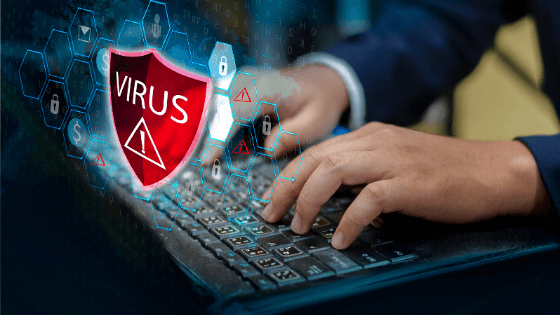Does My Computer Have a Virus or Other Malware? Symptoms & Solutions
 Computers are the center of business and personal productivity in the 21st century. Users expect them to work as intended, on time, and without issue. Unfortunately, this is not always the case. Viruses, or any type of malware (viruses are just one of several types of malware - more on that later), can at the least inconvenience users, and at worst cripple an entire business or organization.
Computers are the center of business and personal productivity in the 21st century. Users expect them to work as intended, on time, and without issue. Unfortunately, this is not always the case. Viruses, or any type of malware (viruses are just one of several types of malware - more on that later), can at the least inconvenience users, and at worst cripple an entire business or organization.
When trouble arises, average users may wonder if their computer is misbehaving. They might suspect malware has compromised their system, but don’t know how to confirm their suspicion.
As a managed service provider (MSP) delivering IT support exclusively in business settings, Innovative primarily sees viruses and malware impacting Windows PCs. Much of the information in this article can apply to both Macs and PCs. But for the sake of simplicity, the examples in this article are Windows-specific. Not that Macs don’t face their own vulnerabilities, but PCs are significantly more prevalent in a traditional business setting.
So, let’s walk through what malware is, how to tell if you have it, and what to do about it.
What is Malware?
Malware is any malicious program or script designed to:
- Damage systems.
- Breach security.
- Gather information.
Common types of malware:
- Virus – self-replicating programs that can spread themselves to other systems to maliciously edit, delete, encrypt, or disable systems functions or data.
- Adware – programs or extensions to programs that serve advertisements that you do not knowingly request.
- Spyware – applications that track computer habits and browsing actives.
- Ransomware – a program that encrypts critical data and demands the user pay a ransom to release control of the data or applications.
How Can Malware Impact Your Business?
Malware of any kind can impact your productivity, revenue, and reputation.
Loss of Productivity
Malware may stop you from using your computer or electronic files altogether. Depending on how much your business relies on electronic information, this brings productivity to a complete halt.
When malware doesn’t completely stop you in your tracks it runs quietly in the background tracking keystrokes and internet activity. This utilizes essential computing resources like memory and processing power, decreasing the resources available to run legitimate programs. As a result, the speed at which you can run software programs and access data is decreased which can significantly slow down the pace of your work.
Loss of Revenue
Your business loses revenue when malware stops or slows essential processes like accepting credit card payments or generating invoices. This can be devastating to small businesses depending on the length of time it takes you to remove the malware and restore your systems.
Loss of Reputation
With so many high-profile data breaches in the news these days, consumers are more aware than ever of who they trust with electronic information. It’s damaging enough when you have to notify customers that a potential breach occurred. In the case of viruses that spread via email or webpage links, your customers may trace suspicious activity back to your business before you even know something occurred. This makes you look like you don’t take cybersecurity seriously and gives consumers second thoughts about trusting you with things like payment information or even their email address.
How Do I Know if I Have Malware?
There are five tell-tale signs malware has infected your computer.
1. An increasing number of pop-ups
This symptom is as old as the public internet, but it remains because it is still effective. A “pop-up” refers to the appearance of unexpected and unwanted windows on your computer. They impede your productivity, offer products or services you didn’t request, or attempt to scam you. Pop-up advertisements appear in two flavors on modern Windows systems.
Phishing Pop-Ups
While browsing the internet, you notice the browser window changes to a pop-up (or series of them). They all warn you that your computer is infected! The pop-up(s) may even make a loud noise and can appear on a mainstream website that you have visited many times. There is usually a phone number to call or link to click for “help” with the alleged infection.
Clicking the link in the scenario above launches a malware infection on your computer. Or it may direct you to a website where you can enter your credit card information to pay a fee for removing the alleged malware. Either way, scammers are using this pop-up as a scam to steal credit card or other sensitive information from your computer.
If you call a phone number, the scammers will answer and ask for permission to remotely access your computer. Then, they will:
- Infect your computer with real malware.
- Present you with nonsensical computer jargon as proof of a malware infection and attempt to convince you to pay a fee allowing them to “clean it.”
It’s important to note that at first, a phishing pop-up is not malware. It is a phishing scheme intended to infect you with malware or convince you to pay a fee to remove fake malware.
Browser Extensions
Browser extensions are programs that add functionality to your web browser. Examples of useful types of browser extensions that you may be familiar with could range from:
- Checking grammar in web forms (Example: Grammarly).
- Saving you money on online purchases (Example: Honey).
- Allowing you to easily document webpage links in third party applications (Example: Evernote).
- Translating webpage content into another language (Example: Google Translate).
More malicious extensions track your activity online. Then they present ads enticing you to click links that download more malware or take you to less than savory websites.
2. Contacts respond to an email that you didn’t send
This is a scary feeling. Someone in your contact list sends you a reply from a message you are certain you did not write. This can mean that a particularly nasty type of malware has infected your machine. Its first order of business is to access all your Outlook or email contacts. Then it sends out emails on your behalf to your contacts in order to spread the infection.
Other ways to tell if malware has affected your email are:
- Check your Outlook rules. Malware that uses email to spread will add or change rules in Microsoft Outlook to move sent messages to the deleted items folder. This helps to prevent detection by keeping maliciously sent emails out of the Sent folder. Many people look at their Sent folder and might notice an email they didn’t send themselves. Fewer users monitor or would notice anything out of order in their Deleted Items folder.
- Check your Outbox, Sent, and Deleted Items folders for large groups of emails sent at the same time with the same subject line.
3. Your homepage changes
Most people get used to their web browser and stick with it if the sites they visit continue to work. Despite this, sometimes users see their homepage change unexpectedly, and think that nothing is wrong! This is a sign that some program or process has altered your homepage without your consent, or at least sneakily obtained your consent. You may see this after:
- Installing a legitimate program. Some software developers take money from other developers to bundle adware or spyware onto their software. These usually have tiny check boxes on one of the many windows that you see during the install process. Most of the time, users do not even see them because let’s face it, nobody wants to sit for thirty minutes reading all the tiny computerese on the install screens.
- Clicking one of the boxes that pop-up on a website asking you to “allow notifications from” the site.
4. Your anti-virus software is disabled, or you can’t visit an anti-virus website.
This is a nasty symptom of malware. Some viruses and malware will disable the anti-virus product that you are using to defend against them. Some of the nastiest ones modify the way your computer accesses websites. They prevent you from even going to the website for an anti-virus provider like mcafee.com or us.norton.com.
5. You can’t access certain files or folders.
Perhaps the most sinister of current threats is ransomware. Once inside your system, ransomware can encrypt databases, files, and folders and then alert you via pop-up or email that they have attacked you. Once they have your attention, they try to extort money in exchange for unlocking your files again.
For home users, this may only be mildly annoying, but a business could have employee files, production databases, or financial documents locked away and inaccessible – essentially grinding the business to a halt.
What to Do If You Have Malware on Your Computer
If you suspect that you may have been affected by malware, there are several steps that you can take.
- Run a malware scanner and cleanup tool. Malwarebytes offers a great free malware scanner. They are also an excellent resource to learn about the latest threats and scams.
- Change your email, active directory, and any other passwords to accounts that may have been impacted or that you may have accessed while the malware was active.
- If you’re still having problems, reinstall your operating system and restore data from your backup.
If you’re not comfortable doing any of this yourself, you’ll need to get the help of a qualified professional. There are several different options for business IT support including working with a managed service provider (MSP).
Antivirus and threat prevention is just one component of your overall IT strategy. Get a head start on your IT strategy with this free Business Technology Inventory and Assessment template.





